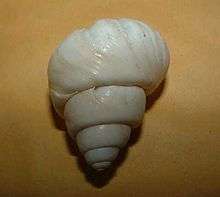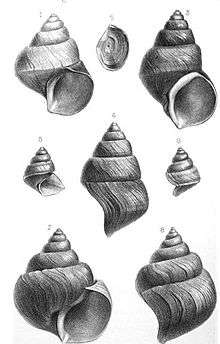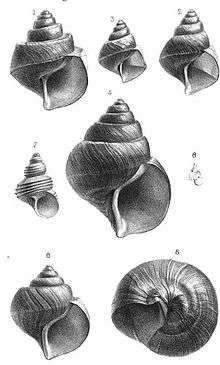Neothauma
Neothauma tanganyicense is a species of freshwater snail with a gill and an operculum, an aquatic gastropod mollusc in the family Viviparidae.
| Neothauma | |
|---|---|
 | |
| shell of Neothauma tanganyicense | |
| Scientific classification | |
| Kingdom: | |
| Phylum: | |
| Class: | |
| (unranked): | |
| Superfamily: | |
| Family: | |
| Genus: | Neothauma E. A. Smith, 1880[2] |
| Species: | N. tanganyicense |
| Binomial name | |
| Neothauma tanganyicense E. A. Smith, 1880[2] | |
Distribution
This freshwater snail is only found in Lake Tanganyika, where it is the largest gastropod, and occurs in all four of the bordering countries — Burundi, the Democratic Republic of the Congo, Tanzania, and Zambia — although fossil shells have been discovered at Lake Edward and in the Lake Albert basin.[1]
The type locality is the East shore of Lake Tanganyika, at Ujiji.[4]

History

The genus Neothauma previously contained several species, but most were reassigned to other genera.[5]
Description
The width of the shell is 46 mm (1.8 in).[4] The height of the shell is 60 mm (2.4 in).[4]
Ecology
This species lives in depths of up to 65 m (213 ft).[4] There is conflicting information relating to its feeding behavior, with one study referring to it as a detritus-feeder,[6] another saying that it actively preys on endobenthic organisms,[7] and finally that it feeds on particulate organic filtered while the snail is buried.[8]
The shells of dead Neothauma tanganyicense often form carpets over large areas, and are used by a number of other animals, such as cichlid fish (shell dwellers),[9] and freshwater crabs of the genus Platythelphusa.[10] Juvenile snails live in the sediment in order to avoid predators.[4]
References
- F. Nicayenzi; C. Ngereza & C. N. Lange (2010). "Neothauma tanganyicense". IUCN Red List of Threatened Species. 2010: e.T14569A4445054. doi:10.2305/IUCN.UK.2010-3.RLTS.T14569A4445054.en.
- Smith E. A. (1880). "On the shells of Lake Tanganyika and of the neighbourhood of Ujiji, central Africa". Proceedings of the Zoological Society of London 1880: 344-352. Page 349. Plate 31.
- Mita E. Sengupta; Thomas K. Kristensen; Henry Madsen & Aslak Jørgensen (2009). "Molecular phylogenetic investigations of the Viviparidae (Gastropoda: Caenogastropoda) in the lakes of the Rift Valley area of Africa". Molecular Phylogenetics and Evolution. 52 (3): 797–805. doi:10.1016/j.ympev.2009.05.007. PMID 19435609.
- Brown D. S. (1994). Freshwater Snails of Africa and their Medical Importance. Taylor & Francis. ISBN 0-7484-0026-5.
- Bourguignat, Jules René (1888-01-01). Iconographie malacologique des animaux mollusques fluviatiles du Lac Tanganika (in French). Impr. Crété.
- Palacios-Fest, M.R.; S.R. Alin; A.S. Cohen; B. Tanner; H. Heuser (2005). "Paleolimnological investigations of anthropogenic environmental change in Lake Tanganyika: IV. Lacustrine paleoecology". Journal of Paleolimnology. 34: 51–71. CiteSeerX 10.1.1.489.2218. doi:10.1007/s10933-005-2397-1.
- Van Damme, D.; Pickford, M. (1998). "The late Cenozoic Viviparidae (Mollusca, Gastropoda) of the Albertine Rift Valley". Hydrobiologia. 390 (1): 171–217. doi:10.1023/A:1003518218109.
- West, K.; Cohen, A.; Baron, M. (1991). "Morphology and behavior of crabs and gastropods from Lake Tanganyika, Africa: Implications for lacustrine predator-prey coevolution". Evolution. 45 (3): 589–607. doi:10.1111/j.1558-5646.1991.tb04331.x. PMID 28568834.
- Stephan Koblmüller; Nina Duftner; Kristina M Sefc; Mitsuto Aibara; Martina Stipacek; Michel Blanc; Bernd Egger & Christian Sturmbauer (2007). "Reticulate phylogeny of gastropod-shell-breeding cichlids from Lake Tanganyika — the result of repeated introgressive hybridization". BMC Evolutionary Biology. 7: 7. doi:10.1186/1471-2148-7-7. PMC 1790888. PMID 17254340.
- N. Cumberlidge; R. von Sternberg; I. R. Bills & H. Martin (1999). "A revision of the genus Platythelphusa A. Milne-Edwards, 1887 from Lake Tanganyika, East Africa (Decapoda: Potamoidea: Platythelphusidae)". Journal of Natural History. 33 (10): 1487–1512. CiteSeerX 10.1.1.654.5532. doi:10.1080/002229399299860.
